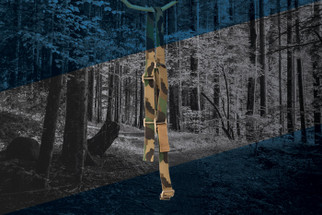Feb 11th 2025
A Brief History of M81 Woodland Camouflage (Aka “God’s Plaid”)
A Brief History of M81 Woodland Camouflage
Aka “God’s Plaid”
Always Better® | February, 12th 2025
During the American Civil War (1861-1865), soldiers started wearing shades of green and brown that would allow them to better blend in with their environment, but World War 1 marked the true beginning of a systematic military camouflage. The French Army created the first dedicated camouflage unit in 1915, called the Section de Camouflage. This unit, comprised largely of artists and designers, developed some of the earliest woodland patterns. The term "camouflage" itself entered the English language during this period, borrowed from the French word camoufler, meaning "to disguise."
World War II saw an explosion in camouflage development. The U.S. Marine Corps introduced the famous "Frogskin" pattern in 1942, featuring green and brown irregular spots on a light background. The German Wehrmacht developed several innovative patterns, including the Splittertarnmuster (splinter pattern) and its various iterations, which influenced camouflage design for decades to come.
During this period, the British Special Operations Executive (SOE) conducted some of the first scientific studies of camouflage effectiveness, leading to the development of the Denison smock pattern used by paratroopers.
Cold War Era and the Birth of M81 Woodland Pattern
The post-war period saw the emergence of what would become one of the most influential and widely-used woodland patterns: the U.S. Military's M81 Woodland pattern. Introduced in 1981, this pattern combined black, brown, green, and khaki in a distinctive arrangement that proved highly effective in temperate forests. The camouflage mimics the natural interplay of light and shadow found in wooded areas and stands as one of the most iconic and enduring military camouflage patterns ever created. Effective woodland camouflage relies on three key principles: color matching, pattern disruption, and shadow elimination. Colors must accurately reflect the operating environment, while patterns break up the wearer's outline. The design must also minimize the sharp shadows that human forms typically cast, helping personnel blend seamlessly into forest environments.
What made M81 Woodland particularly remarkable was its versatility and effectiveness across a wide range of environments. The pattern proved surprisingly effective not just in forests, but also in jungle environments and even semi-arid regions with sufficient vegetation. It became the standard issue pattern for all branches of the U.S. military throughout the 1980s and 1990s, seeing extensive use in operations from Grenada to Panama, and during the first Gulf War. It gained the nickname "God's Plaid" from service members' recognition of its exceptional effectiveness and reliability in the field.
The influence of M81 Woodland extended far beyond American forces. The pattern was so successful that it was widely copied and adapted by military forces worldwide, with numerous countries either directly adopting the pattern or creating close variants. Even after the U.S. military began transitioning to digital patterns in the 2000s, M81 Woodland remained in use with various units and continues to be used by some U.S. military and law enforcement units today. The pattern's enduring legacy and effectiveness have made it a benchmark against which newer camouflage patterns are often measured, and its influence can still be seen in modern military and civilian camouflage designs.
Vickers Sling Limited-Edition in Woodland Camo
For a limited time, we’re offering our flagship sling – the Vickers Sling – in the classic Woodland Camo pattern. This limited-edition sling pays homage to the iconic pattern made popular over 40 years ago. Crafted with the same uncompromising quality and attention to detail that defines Blue Force Gear, this sling is built to perform under the toughest conditions.
This limited run celebrates both form and function, offering collectors and operators alike a piece of tactical heritage without compromising performance. Like the other limited runs we release, this sling won’t be available for long so act fast! Don't miss your chance to own this unique combination of proven design and classic camouflage.
If you’re reading this article and missed the exclusive release, don’t fret! Sign up for our newsletter so you’re the first to know when we have limited edition items.
About Chris Sizelove
Chris Sizelove is a retired Master Sergeant who had a distinguished career in the U.S. Army. Joining in 1999, he served in various capacities in the elite 75th Ranger Regiment spanning across the 2nd, 3rd, and 1st Battalions. His extensive service includes roles as a Pre-Ranger Instructor and a pivotal participant in forming the Regimental Special Troops Battalion (RSTB). Sizelove also held the elite position of Master Breacher of the Regiment and later transitioned to roles in the Defense Intelligence Agency.
About Blue Force Gear®
BFG, headquartered in Pooler, Georgia, has been a trusted name in professional-grade gear and accessories for two decades. Their commitment to excellence, innovative designs, and use of premium materials have made them a favorite among military, law enforcement, and recreational shooters worldwide.
Press Contact
PR Contact: Marketing@blueforcegear.com
Sales and Dealer Contact: Sales@blueforcegear.com

